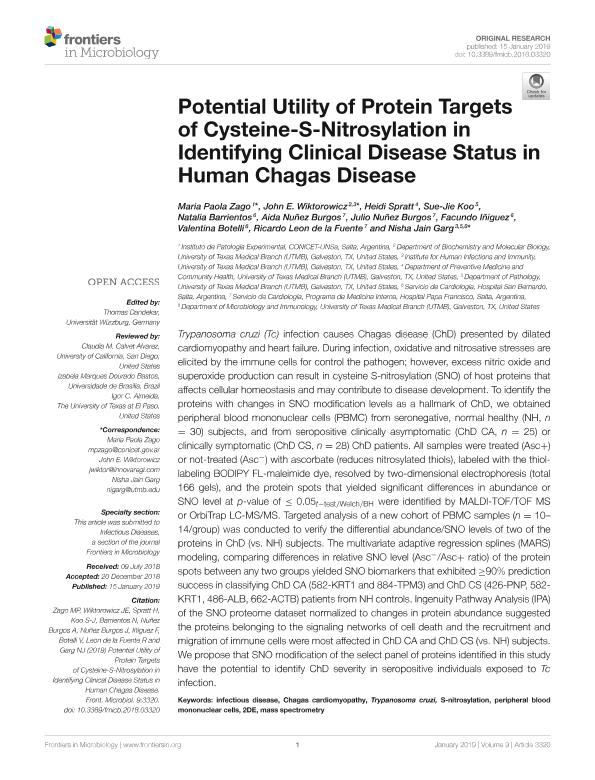Mostrar el registro sencillo del ítem
dc.contributor.author
Zago, María Paola

dc.contributor.author
Wiktorowicz, John E.
dc.contributor.author
Spratt, Heidi
dc.contributor.author
Koo, Sue Jie
dc.contributor.author
Barrientos, Natalia Mariel

dc.contributor.author
Nuñez Burgos, Aida
dc.contributor.author
Nuñez Burgos, Julio
dc.contributor.author
Iñiguez, Facundo
dc.contributor.author
Botelli, Valentina
dc.contributor.author
Leon de la Fuente, Ricardo Alfonso

dc.contributor.author
Garg, Nisha Jain
dc.date.available
2020-11-09T18:48:33Z
dc.date.issued
2019-01
dc.identifier.citation
Zago, María Paola; Wiktorowicz, John E.; Spratt, Heidi; Koo, Sue Jie; Barrientos, Natalia Mariel; et al.; Potential utility of protein targets of cysteine-s-nitrosylation in identifying clinical disease status in human chagas disease; Frontiers Media S.A.; Frontiers in Microbiology; 9; 3320; 1-2019; 1-21
dc.identifier.uri
http://hdl.handle.net/11336/117966
dc.description.abstract
Trypanosoma cruzi (Tc) infection causes Chagas disease (ChD) presented by dilated cardiomyopathy and heart failure. During infection, oxidative and nitrosative stresses are elicited by the immune cells for control the pathogen; however, excess nitric oxide and superoxide production can result in cysteine S-nitrosylation (SNO) of host proteins that affects cellular homeostasis and may contribute to disease development. To identify the proteins with changes in SNO modification levels as a hallmark of ChD, we obtained peripheral blood mononuclear cells (PBMC) from seronegative, normal healthy (NH, n = 30) subjects, and from seropositive clinically asymptomatic (ChD CA, n = 25) or clinically symptomatic (ChD CS, n = 28) ChD patients. All samples were treated (Asc+) or not-treated (Asc−) with ascorbate (reduces nitrosylated thiols), labeled with the thiollabeling BODIPY FL-maleimide dye, resolved by two-dimensional electrophoresis (total 166 gels), and the protein spots that yielded significant differences in abundance or SNO level at p-value of ≤ 0.05t−test/Welch/BH were identified by MALDI-TOF/TOF MS or OrbiTrap LC-MS/MS. Targeted analysis of a new cohort of PBMC samples (n = 10– 14/group) was conducted to verify the differential abundance/SNO levels of two of the proteins in ChD (vs. NH) subjects. The multivariate adaptive regression splines (MARS) modeling, comparing differences in relative SNO level (Asc−/Asc+ ratio) of the protein spots between any two groups yielded SNO biomarkers that exhibited ≥90% prediction success in classifying ChD CA (582-KRT1 and 884-TPM3) and ChD CS (426-PNP, 582- KRT1, 486-ALB, 662-ACTB) patients from NH controls. Ingenuity Pathway Analysis (IPA) of the SNO proteome dataset normalized to changes in protein abundance suggested the proteins belonging to the signaling networks of cell death and the recruitment and migration of immune cells were most affected in ChD CA and ChD CS (vs. NH) subjects. We propose that SNO modification of the select panel of proteins identified in this study have the potential to identify ChD severity in seropositive individuals exposed to Tc infection.
dc.format
application/pdf
dc.language.iso
eng
dc.publisher
Frontiers Media S.A.

dc.rights
info:eu-repo/semantics/openAccess
dc.rights.uri
https://creativecommons.org/licenses/by/2.5/ar/
dc.subject
2DE
dc.subject
CHAGAS CARDIOMYOPATHY
dc.subject
INFECTIOUS DISEASE
dc.subject
MASS SPECTROMETRY
dc.subject
PERIPHERAL BLOOD MONONUCLEAR CELLS
dc.subject
S-NITROSYLATION
dc.subject
TRYPANOSOMA CRUZI
dc.subject.classification
Parasitología

dc.subject.classification
Ciencias de la Salud

dc.subject.classification
CIENCIAS MÉDICAS Y DE LA SALUD

dc.title
Potential utility of protein targets of cysteine-s-nitrosylation in identifying clinical disease status in human chagas disease
dc.type
info:eu-repo/semantics/article
dc.type
info:ar-repo/semantics/artículo
dc.type
info:eu-repo/semantics/publishedVersion
dc.date.updated
2020-05-19T19:45:14Z
dc.identifier.eissn
1664-302X
dc.journal.volume
9
dc.journal.number
3320
dc.journal.pagination
1-21
dc.journal.pais
Suiza

dc.description.fil
Fil: Zago, María Paola. Consejo Nacional de Investigaciones Científicas y Técnicas. Centro Científico Tecnológico Conicet - Salta. Instituto de Patología Experimental. Universidad Nacional de Salta. Facultad de Ciencias de la Salud. Instituto de Patología Experimental; Argentina
dc.description.fil
Fil: Wiktorowicz, John E.. University of Texas Medical Branch; Estados Unidos
dc.description.fil
Fil: Spratt, Heidi. University of Texas Medical Branch; Estados Unidos
dc.description.fil
Fil: Koo, Sue Jie. University of Texas Medical Branch; Estados Unidos
dc.description.fil
Fil: Barrientos, Natalia Mariel. Hospital San Bernardo. Servicio de Cardiología; Argentina
dc.description.fil
Fil: Nuñez Burgos, Aida. Hospital Papa Francisco. Programa de Medicina Interna. Servicio de Cardiología; Argentina
dc.description.fil
Fil: Nuñez Burgos, Julio. Hospital Papa Francisco. Programa de Medicina Interna. Servicio de Cardiología; Argentina
dc.description.fil
Fil: Iñiguez, Facundo. Hospital San Bernardo. Servicio de Cardiología; Argentina
dc.description.fil
Fil: Botelli, Valentina. Hospital San Bernardo. Servicio de Cardiología; Argentina
dc.description.fil
Fil: Leon de la Fuente, Ricardo Alfonso. Hospital Papa Francisco. Programa de Medicina Interna. Servicio de Cardiología; Argentina
dc.description.fil
Fil: Garg, Nisha Jain. University of Texas Medical Branch; Estados Unidos
dc.journal.title
Frontiers in Microbiology
dc.relation.alternativeid
info:eu-repo/semantics/altIdentifier/doi/http://dx.doi.org/10.3389/fmicb.2018.03320
dc.relation.alternativeid
info:eu-repo/semantics/altIdentifier/url/https://www.frontiersin.org/articles/10.3389/fmicb.2018.03320/full
Archivos asociados
